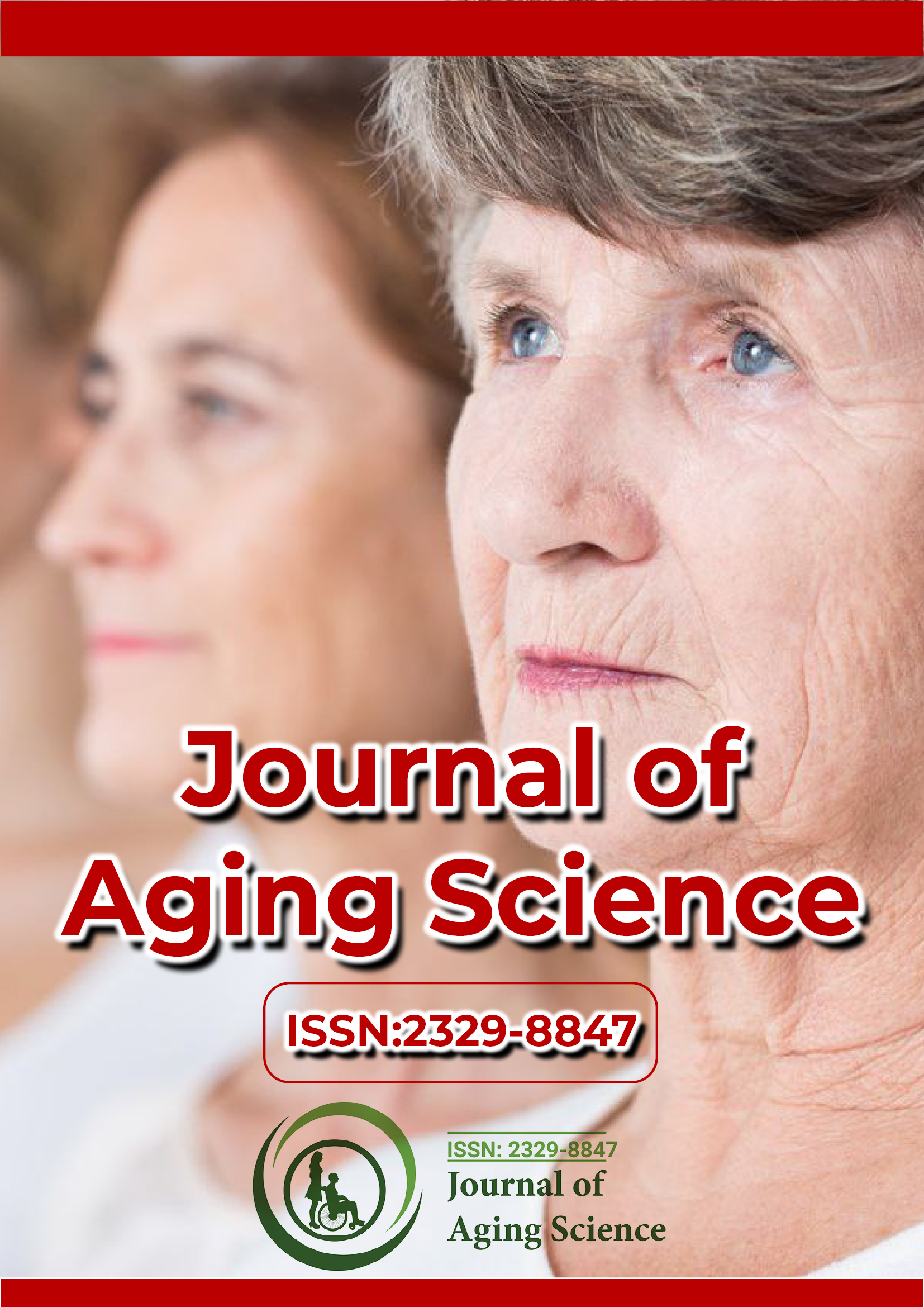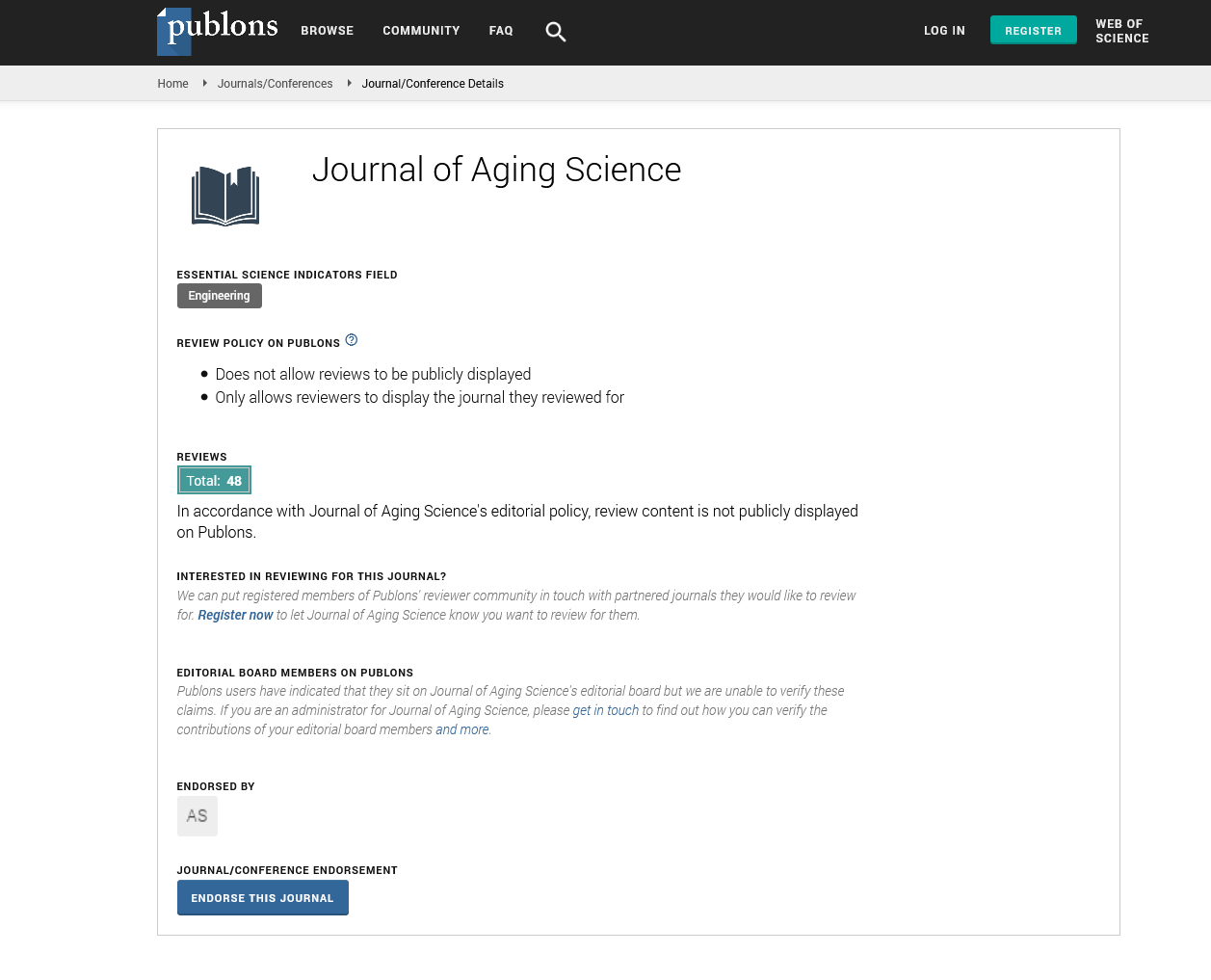Indexed In
- Open J Gate
- Academic Keys
- JournalTOCs
- ResearchBible
- RefSeek
- Hamdard University
- EBSCO A-Z
- OCLC- WorldCat
- Publons
- Geneva Foundation for Medical Education and Research
- Euro Pub
- Google Scholar
Useful Links
Share This Page
Journal Flyer

Open Access Journals
- Agri and Aquaculture
- Biochemistry
- Bioinformatics & Systems Biology
- Business & Management
- Chemistry
- Clinical Sciences
- Engineering
- Food & Nutrition
- General Science
- Genetics & Molecular Biology
- Immunology & Microbiology
- Medical Sciences
- Neuroscience & Psychology
- Nursing & Health Care
- Pharmaceutical Sciences
Perspective - (2025) Volume 13, Issue 2
The Effect of Lifelong Exercise on Aging and Physical Performance
David Lam*Received: 28-Mar-2025, Manuscript No. JASC-25-28624; Editor assigned: 31-Mar-2025, Pre QC No. JASC-25-28624 (PQ); Reviewed: 07-Apr-2025, QC No. JASC-25-28624; Revised: 14-Apr-2025, Manuscript No. JASC-25-28624 (R); Published: 28-Apr-2025, DOI: 10.35248/2329-8847.25.13.408
Description
Aging is an inevitable process characterized by physiological changes that affect various systems in the body, including musculoskeletal strength, cardiovascular function and metabolic health. However, research has consistently demonstrated that lifelong exercise can significantly slow down many of these agingrelated declines, enhancing both longevity and quality of life. Physical activity influences muscle strength, bone density, cardiovascular efficiency, cognitive function and metabolic health, making it a key factor in promoting healthy aging. Understanding the effects of lifelong exercise on physical performance and aging provides valuable insights into how individuals can maintain optimal health and functional independence as they grow older.
Musculoskeletal health and lifelong exercise
One of the most pronounced effects of aging is the gradual decline in muscle mass and strength, a condition known as sarcopenia. This decline typically begins around the fourth decade of life and accelerates with age, leading to reduced mobility, increased fall risk and loss of independence. Lifelong exercise, particularly resistance training, plays a critical role in mitigating these effects by stimulating muscle protein synthesis and enhancing neuromuscular function.
Strength training and muscle retention: Regular resistance training has been shown to preserve muscle mass, improve coordination and increase overall strength in older adults. Studies have found that older individuals who engage in lifelong strength training retain significantly more muscle mass compared to sedentary individuals.
Bone density maintenance: Weight-bearing exercises such as running, jumping and resistance training help maintain bone mineral density, reducing the risk of osteoporosis and fractures.
Joint health and flexibility: Exercises such as yoga and stretching routines improve joint mobility and flexibility, reducing stiffness and the risk of injuries.
Cardiovascular health and endurance training
Aging is often associated with a decline in cardiovascular efficiency, leading to increased risks of heart disease, hypertension and reduced aerobic capacity. However, lifelong endurance training, such as running, swimming and cycling, can significantly enhance cardiovascular function by improving heart efficiency and circulation.
Improved heart function: Regular aerobic exercise strengthens the heart muscle, improving cardiac output and oxygen delivery to tissues. Studies show that older adults who have engaged in lifelong endurance training exhibit higher stroke volume and better overall cardiac function compared to their sedentary counterparts.
Blood pressure regulation: Exercise helps maintain healthy blood pressure by enhancing blood vessel elasticity and reducing arterial stiffness, both of which tend to decline with age.
Enhanced oxygen utilization: Endurance training improves the body’s ability to use oxygen efficiently, delaying the decline in maximal oxygen uptake (VO2 max) that occurs with aging.
Metabolic health and lifelong physical activity
Aging is often accompanied by metabolic changes, including insulin resistance, increased body fat and a higher risk of metabolic syndrome. Regular exercise plays an important role in regulating metabolism and maintaining a healthy body composition.
Improved insulin sensitivity: Physical activity enhances insulin function, reducing the risk of type 2 diabetes and improving glucose metabolism.
Weight management: Regular exercise helps maintain a healthy body weight by increasing energy expenditure and preserving lean muscle mass.
Reduced inflammation: Chronic low-grade inflammation is an attribute of aging and contributes to various age-related diseases. Lifelong exercise has been shown to reduce systemic inflammation by modulating immune function and decreasing pro-inflammatory markers.
Cognitive benefits of lifelong exercise
Cognitive decline is a common aspect of aging, with conditions such as dementia and Alzheimer’s disease becoming more prevalent in older populations. Exercise has an extreme impact on brain health by promoting neurogenesis, enhancing blood flow to the brain and reducing cognitive decline.
Neuroprotection: Exercise stimulates the production of brainderived neurotrophic factor (BDNF), a protein necessary for brain plasticity and neuron survival.
Memory and learning: Studies indicate that physically active individuals maintain better memory, learning ability and executive function compared to sedentary individuals.
Reduced risk of neurodegenerative diseases: Regular physical activity is associated with a lower risk of developing Alzheimer’s disease and other forms of dementia.
Psychological well-being and quality of life
Beyond physical health, exercise significantly contributes to psychological well-being and emotional resilience, helping individuals maintain a high quality of life as they age.
Mood enhancement: Physical activity stimulates the release of endorphins, serotonin and dopamine, which help reduce stress, anxiety and depression.
Social engagement: Participating in group exercises, sports, or fitness communities encourages social interactions, which are important for mental health and emotional stability.
Improved sleep patterns: Regular physical activity has been shown to enhance sleep quality by regulating circadian rhythms and reducing insomnia.
Lifespan extension and longevity
Studies have consistently linked lifelong exercise with increased lifespan and a reduced risk of premature mortality. Physically active individuals tend to live longer, healthier lives due to the cumulative benefits of improved cardiovascular health, metabolic function and mental well-being.
Lower mortality risk: Research indicates that regular exercise is associated with a lower risk of all-cause mortality, with benefits seen across different age groups.
Compression of morbidity: Lifelong exercisers tend to experience a shorter period of illness and disability before death, maintaining functional independence for a longer duration.
Practical recommendations for lifelong exercise
To maximize the benefits of lifelong exercise and promote healthy aging, individuals should adopt a well-rounded fitness routine that includes:
Aerobic exercise: Engaging in moderate-to-vigorous aerobic activity (e.g., brisk walking, swimming, cycling) for at least 150 minutes per week.
Strength training: Incorporating resistance exercises at least twice per week to maintain muscle mass and strength.
Flexibility and balance training: Performing activities such as yoga or tai chi to enhance mobility and prevent falls.
Conclusion
Lifelong exercise is potential intervention for promoting healthy aging and maintaining physical performance. It helps preserve muscle mass, enhance cardiovascular function, regulate metabolism, improve cognitive function and boost psychological well-being. By incorporating regular physical activity into daily life, individuals can mitigate the negative effects of aging, extend their healthspan and improve their overall quality of life.
Citation: Lam D (2025). The Effect of Lifelong Exercise on Aging and Physical Performance. J Aging Sci. 13:407.
Copyright: © 2025 Lam D. This is an open-access article distributed under the terms of the Creative Commons Attribution License, which permits unrestricted use, distribution and reproduction in any medium, provided the original author and source are credited.

